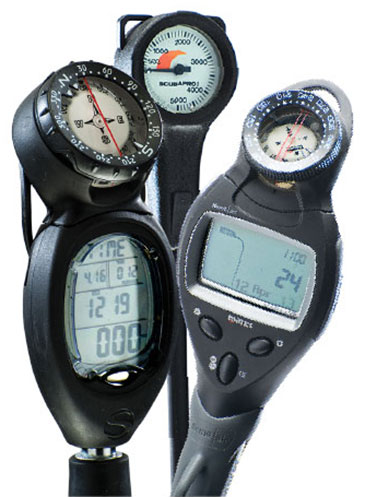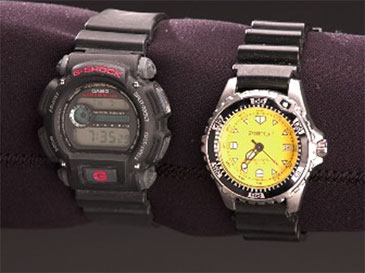Lesson 53
Objectives
By the end of this section, I should be able to answer these questions:
1. What are the three primary instruments I use while diving, and what do I use each one for?
2. What three optional instruments may I choose to use while diving?
3.
How do I care for dive instruments?
Dive Instruments
You’ve already learned a bit about some dive instruments, but let’s look at them more closely. There are three primary instruments you use on virtually all dives.
SPG (submersible pressure gauge) – As you’ve learned, this instrument tells you how much air remains in your cylinder. It may be a separate gauge or integrated into your dive computer.
Dive computer – Besides tracking your time underwater, how deep you are and other information, this instrument guides you in keeping dissolved nitrogen in your body within accepted limits. It does this by applying depth and time information to a decompression model, constantly showing how much time you have left
A couple of things your want to be sure you able to locate on your dive computer (or the one your are renting)
1.) Depth (always need to know your depth.
2.) Air (some computers have air integrated into them
3.) NDL (no decompression limit)
4.) Bottom Time
More about dive computers in Sections Four and Five.

Compass – Your compass provides a navigational reference to help you follow a course and find your way back to your exit. Compasses designed for diving are pressure resistant and have clear markings. Your compass, SPG and dive computer may be combined into a single, multifunction instrument.
Besides your primary instruments, there are some optional ones you may want, or need in some circumstances.
Depth gauge and dive watch – Before dive computers, these were mandatory for use with dive tables like the Recreational Dive Planner (RDP) to track dissolved nitrogen in your body and plan your dive time limits. If you use the RDP Table or eRDPML and don’t have a dive computer (more about why you might do this in Section Four), you will need these. Although not commonly used today, there are single instruments that combine your depth gauge and timer.

Dive watches – Dive watches are popular as lifestyle accessories that identify you as a diver. Many divers wear them all the time.
Thermometer – Thermometers help you determine how much exposure protection you need. They show the water temperature, which helps you determine how much exposure protection you want on later dives. Although available as separate instruments, they are commonly part of SPGs, depth gauges and dive computers.
Care
Dive instruments have some maintenance and care considerations other than rinsing in fresh water after use. Although tough, they are instruments. Protect them from impact, and like most electronics they don’t do well if exposed to direct sunlight or high heat for long periods. Keep them in the shade, and face them away from the sun or cover them when you can’t.
Change the batteries in electronic instruments (primarily dive computers) as directed by the manufacturer. The requirements for this vary, so see the manufacturer literature for the details on your computer, as well as for any additional care requirements.
Quick quiz
Module Two

I'll take you diving!
Copyright © Larry Wedgewood Scuba Instruction All Rights Reserved

